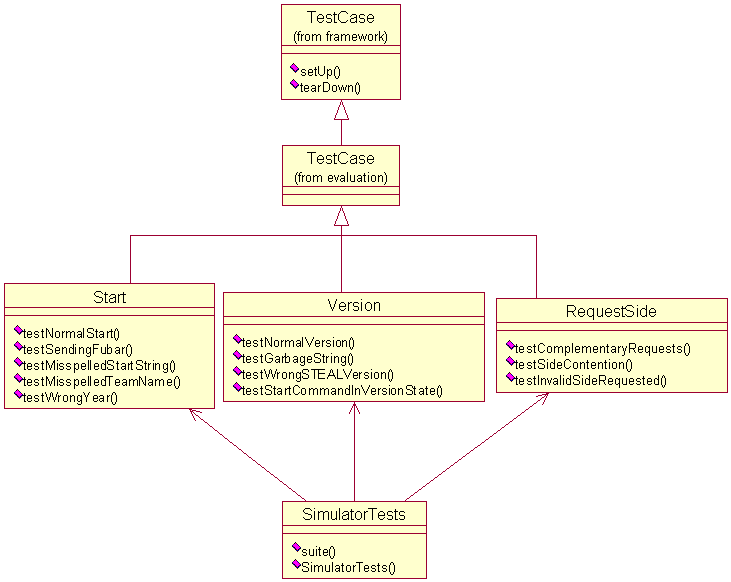Sim Tester (Framework)
The Sim Tester is a CTF simulator testing framework, built on JUnit and the CTF Tools, meant to make system-level simulator testing easy. It also uses a technology called AspectJ, but you do not have to have AspectJ installed to develop and run tests.
The test architecture is based on JUnit. A TestSuite object contains a number of TestCase objects, which has public methods whose names begin in "test". Each of these methods is a test to be run by JUnit.
In our case, we have TestCase objects like Start and Version, which extend ctf.evaluation.TestCase, which extends junit.framework.TestCase (and adds a few useful methods). These TestCase objects are aggregated by the ctf.evaluation.simulator.SimulatorTests object, which is a junit.framework.TestSuite.

Adding a new TestCase (e.g. for another STEAL state) requires two steps: creating the TestCase and adding it to SimulatorTests.
The first
step, creating the TestCase, can be accomplished by following this
template:
package ctf.evaluation.simulator;
import java.io.IOException;
import ctf.network.*;
import ctf.evaluation.TestCase;
import ctf.evaluation.simulator.responses.*;
import static ctf.evaluation.simulator.ConnectionManager.STEALState.*;
/** Tests the STEAL state 'Foo' */ @SimulatorTest public class Foo extends TestCase
{
/** Set up for a test */ @Override public void setUp()
throws IOException, NetworkException, ProtocolError
{
connections.enterState(START);
red = connections.red();
blue = connections.blue();
}
/** Tear down after a test */ @Override public void tearDown() {}
/** Test the ability of the simulator to do something. */ public void testSomething()
throws IOException, NetworkException
{
red.sendLine("xxxxxxxx");
blue.sendLine("xxxxxxxx");
assertClose(3.14159, (new XXXXResponse(red)).aValue());
assertEqual(3, (new XXXXResponse(blue)).anotherValue());
}
/** Something else happens. */ public void testDoSomethingElse()
throws IOException, NetworkException, ProtocolError
{
blue.sendLine("xxxxxxxx");
sleep(100);
red.sendLine("xxxxxxxx");
new ErrorResponse(blue);
new ErrorResponse(red);
}
/** The connection manager */ private ConnectionManager connections = ConnectionManager.instance();
/** Actual connections to the simulator */ private ctf.network.tcp.Connection red, blue;
}
The second step, modifying ctf.evaluation.simulator.SimulatorTests, looks like this:
// ...
public SimulatorTests()
throws IOException, NetworkException, ProtocolError
{
addTestSuite(ctf.evaluation.simulator.Start.class);
addTestSuite(ctf.evaluation.simulator.Version.class);
addTestSuite(ctf.evaluation.simulator.RequestSide.class);
addTestSuite(ctf.evaluation.simulator.Something.class);
}
// ...
Once you've created the skeleton of a TestCase, you're ready to carry on with fleshing it out: adding actual tests.